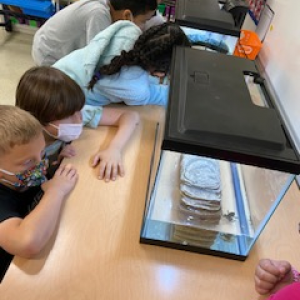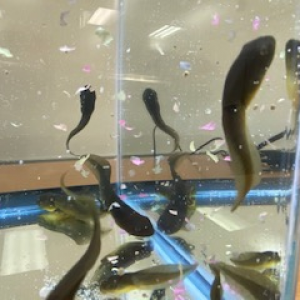Clements/Parsons Elementary second graders leap into learning
Ellise Valdez watched as the tadpoles darted through the water. It was not long until the Clements/Parsons Elementary second grader and her classmates watched the tiny amphibians fully develop into an entirely new creature.
“It’s cool to see the tadpoles swimming with their tiny legs and becoming adult frogs,” Valdez said. “I love learning new things.”
While many classes use butterflies to observe and investigate the natural world to reveal patterns, changes and cycles, teachers Barbara Miller and Sheila Wright chose tadpoles to engage students in lessons about life cycles and how animals, with their physical characteristics, survive in their environments.
“Waiting for the caterpillars to change can seem like a long time when you don’t see an actual change from day to day,” Miller said. “I love using the tadpoles because of the activity and energy.”
Miller is a virtual teacher this year and knew she needed something exciting and fast growing to keep at-home learners engaged. She also wanted to use something that could not only be seen easily through the computer but that was also exciting in person. Miller said the students were amazed that a frog actually started as a tadpole.
“They were intrigued at how the frogs’ physical characteristics were so different from the beginning to the end result,” Miller said. “The most rewarding part of the lesson was seeing the excitement the children had learning about the process. I enjoy being able to ignite that spark so that they develop a love for learning.”
At-home and on-campus students enjoyed learning about and watching the tadpoles grow. On-campus students came in daily to observe, assess, and track the growth and change of the tadpoles.
Teacher Sheila Wright enjoyed seeing the correlation that students drew between themselves and the development of the frog.
“I loved seeing students making the connection between themselves starting out as a baby and growing just as the tadpole did turning into a frog.”
Both teachers were surprised how many staff members were as intrigued as the students to see the transformations of the tadpoles to frogs.
“Sometimes as busy adults, we get caught up in everyday tasks and responsibilities,” Wright said. “So, it was nice for everyone to stop and see that life was happening in our classrooms.”
Miller hopes students will apply their knowledge with an understanding about processes and how we, as human, are able to adapt and thrive in our own environments. “We all have different characteristics that help us live amongst each other,” Miller said. “We are all different, but we are all one team.”



